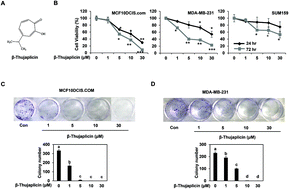β-Thujaplicin inhibits basal-like mammary tumor growth by regulating glycogen synthase kinase-3β/β-catenin signaling
Abstract
β-Thujaplicin, a natural monoterpenoid, has been demonstrated to exert health beneficial activities in chronic diseases. However, it has not been studied in regulating estrogen receptor (ER) negative breast cancer. Here, we investigated the effect of β-thujaplicin on inhibiting ER-negative basal-like breast cancer and the underlying mechanism of action using an in vitro and in vivo xenograft animal model. β-Thujaplicin induced G0/G1 phase cell cycle arrest and regulated cell cycle mediators, cyclin D1, cyclin E, and cyclin-dependent kinase 4 (CDK 4), leading to the inhibition of the proliferation of ER-negative basal-like MCF10DCIS.com human breast cancer cells. It also modulated the phosphorylation of protein kinase B (AKT) and glycogen synthase kinase (GSK-3β) and the protein level of β-catenin. In an MCF10DCIS.com xenograft animal model, β-thujaplicin significantly inhibited tumor growth, reduced tumor weight, and regulated the expression of cell cycle proteins, phosphorylation of AKT and GSK-3β, and protein level of β-catenin in the tumor tissues. These results demonstrate that β-thujaplicin can suppress basal-like mammary tumor growth by regulating GSK-3β/β-catenin signaling, suggesting that β-thujaplicin may be a potent chemopreventive agent against the basal-like subtype of breast cancer.



 Please wait while we load your content...
Please wait while we load your content...